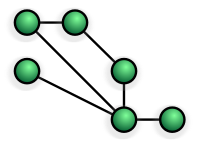
Photo from wikipedia
The network-shaped body plan distinguishes the unicellular slime mould Physarum polycephalum in body architecture from other unicellular organisms. Yet, network-shaped body plans dominate branches of multi-cellular life such as in… Click to show full abstract
The network-shaped body plan distinguishes the unicellular slime mould Physarum polycephalum in body architecture from other unicellular organisms. Yet, network-shaped body plans dominate branches of multi-cellular life such as in fungi. What survival advantage does a network structure provide when facing a dynamic environment with adverse conditions? Here, we probe how network topology impacts P. polycephalum’s avoidance response to an adverse blue light. We stimulate either an elongated, I-shaped amoeboid or a Y-shaped networked specimen and subsequently quantify the evacuation process of the light-exposed body part. The result shows that Y-shaped specimen complete the avoidance retraction in a comparable time frame, even slightly faster than I-shaped organisms, yet, at a lower almost negligible increase in migration velocity. Contraction amplitude driving mass motion is further only locally increased in Y-shaped specimen compared to I-shaped—providing further evidence that Y-shaped’s avoidance reaction is energetically more efficient than in I-shaped amoeboid organisms. The difference in the retraction behaviour suggests that the complexity of network topology provides a key advantage when encountering adverse environments. Our findings could lead to a better understanding of the transition from unicellular to multicellularity.
Journal Title: Physical Biology
Year Published: 2023
Link to full text (if available)
Share on Social Media: Sign Up to like & get
recommendations!